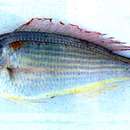Diagnostic Description
provided by Fishbase
This species is distinguished by the following characters: lower margin of eye above a line from tip of snout to upper base of pectoral fins; a line drawn up from the posterior edge of suborbital reaching the dorsal profile 2 to 4 scale rows before origin of dorsal fin; pectoral fins very long, 1-1.3 in HL, reaching to or just beyond level of origin of anal fin; pelvic fins moderately long, 1.2-1.6 in HL, reaching to or just beyond anus; caudal fin moderately forked, upper lobe slightly longer than lower and produced into a short or moderately long filament. Colour: upper part of body pinkish, becoming silvery below; top of head behind eye with a golden sheen; 11-12 pale golden-yellow stripes along body from behind head to base of caudal fin; a prominent red-suffused yellow blotch below origin of lateral line; dorsal fin whitish, margin of fin yellow, edged with red; a pale lemon stripe near base of dorsal fin, this stripe narrow anteriorly and widening on posterior part of fin; anal fin whitish with pale lemon broken lines or scribblings over most of fin; caudal fin pink, upper tip and filament yellow (Ref. 9785).
Diseases and Parasites
provided by Fishbase
Glugea nemipteri Disease. Parasitic infestations (protozoa, worms, etc.)
Diseases and Parasites
provided by Fishbase
Nosema Disease. Parasitic infestations (protozoa, worms, etc.)
Diseases and Parasites
provided by Fishbase
Helixaxine Disease. Parasitic infestations (protozoa, worms, etc.)
Life Cycle
provided by Fishbase
Females predominate at small sizes and males at larger sizes, due to faster growth rate in males (Ref. 6254).
Morphology
provided by Fishbase
Dorsal spines (total): 10; Dorsal soft rays (total): 9; Analspines: 3; Analsoft rays: 7
Trophic Strategy
provided by Fishbase
Small fish are generally most abundant in less than 27 m depth; only larger fish occur in depths greater than 45 m (Ref. 1065). Dietary preferences were crustaceans, finfishes, molluscs, polychaetes and unidentified matter (Ref. 116460).
Biology
provided by Fishbase
Very abundant in coastal waters, found on mud or sand bottoms, usually in schools. Feeds mainly on small fishes, crustaceans, mollusks (mainly cephalopods), polychaetes and echinoderms. Marketed mainly fresh, but also frozen, steamed, dried-salted, dry-smoked, fermented or made into fish balls and fish meal.
- Recorder
- Kent E. Carpenter
Importance
provided by Fishbase
fisheries: commercial
- Recorder
- Kent E. Carpenter

